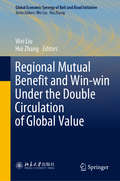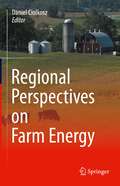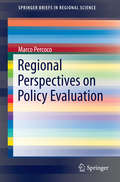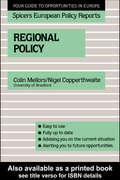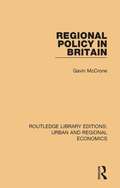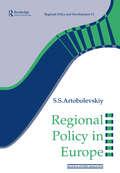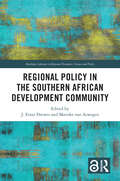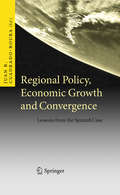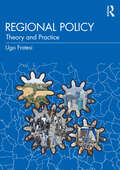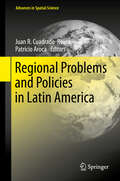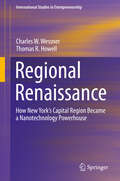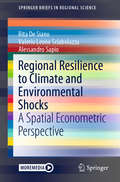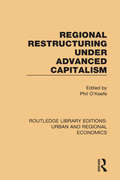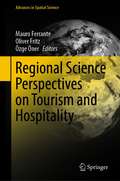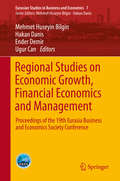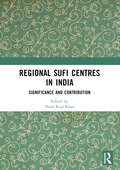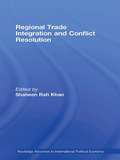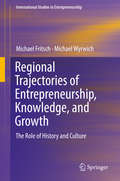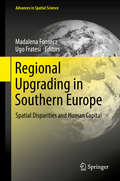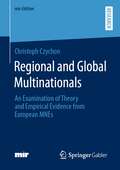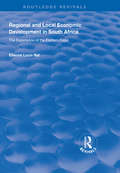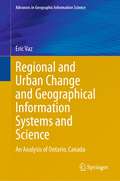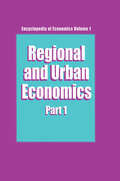- Table View
- List View
Regional Mutual Benefit and Win-win Under the Double Circulation of Global Value (Global Economic Synergy of Belt and Road Initiative)
by Wei Liu Hui ZhangThe book offers an in-depth research of the economic situations along the Belt and Road and the initiative’s cooperation prospects, opportunities and challenges. It draws on economic data, including those on trade, investment, infrastructure, urban distribution, industrial cooperation, financial integration and revision of historical and political background. The Belt and Road initiative (BRI) comes from not only the ancient Silk Road, but also a long-term international cooperation between China and relevant countries. As a China-led initiative, the BRI is built upon China’s international vision according to its development process. Therefore, the book also discusses how China balances its own development process among different domestic regions, and how the Initiative fits into the changes of global economic system and brings positive change for developing and developed economies involved, on the long haul. Furthermore, this book aims to find out precise direction of the initiative in order to assess appropriate implication on development under current globalization and provide valuable experience for future economic synergetic development by reviewing the past cooperative experience as references for policy-making and prospective engagementIn terms of methodology, analyses were conducted applying multi-methods with best available evidence to enrich the understanding of the potential of the BRI in terms of socio-economic impact on cooperation and difference and similarities of economic, cultural characteristics and political system among countries.
Regional Perspectives on Farm Energy
by Daniel CiolkoszThis book examines the characteristics and opportunities for farm energy in the northeast quadrant of the United States, with attention to energy use, strategic energy management, and energy production by solar, wind, biomass, and other means. Throughout, the distinct characteristics of the region and their impact on energy solutions are discussed, and the outlook for future energy strategies is considered. Farm energy production and use are topics of increasing interest, as the need for improved efficiency and the opportunity for sustainable energy production both drive agricultural enterprises to reduce energy use and pursue opportunities for renewable energy production and use on the farm. However, the unique regional characteristics of agriculture make it challenging to apply a single approach to all situations.
Regional Perspectives on Policy Evaluation
by Marco PercocoThe evaluation of public policies is of paramount importance for modern policy making, especially in a period of severe budget constraints. The literature has proposed several methods to deal with the issue of causality and counterfactual evaluation in a variety of contexts, with an increasing attention to the local dimension. The book aims to present the state-of-the-art of evaluation techniques with a special focus on the consideration of geographical and spatial effects into existing methodologies (such as propensity score matching, regression discontinuity, difference-in-difference). Furthermore, the volume highlights how strict the identification conditions for models with spatial effects are and proposes instrumental variables as a technique able to circumvent the issue. Finally, some insights into the emerging literature on ex ante evaluation are offered with respect to EU Cohesion Policy.
Regional Policy (Spicers European Policy Reports)
by Colin Mellors Nigel CopperthwaiteThe European Community has committed itself to promoting 'economic and social cohesion' across its regions. Its expenditure - via the 'structural funds' - for these purposes is set to double by 1993. A key component of such expenditure is the European Regional Development Fund, which is receiving increasing attention from local and regional representatives and officials, as well as from companies considering where to locate their businesses. The integrated development operations of the EC involve important new initiatives at the local level. This volume explains how the ERDF operates and its relationship to other sources of funding from the EC. It offers comprehensive and up-to-date information, in a readily accessible format. Section II summarises the key EC policy documents involved, and Section III gives a full listing of all the relevant documents across a range of different aspects.
Regional Policy in Britain (Routledge Library Editions: Urban and Regional Economics)
by Gavin McCroneOriginally published in 1973. At that time, imbalance in the economic performance of regions had become of increasing concern to politicians and economists in many European counties. British policy was of particular interest: not only because the changes of the 1960s made it more comprehensive than in most other countries; but as some sort of regional policy had been in operation for more than thirty years, many lessons could be learned from its evolution. This book provides a comprehensive study of this aspect of British policy. It starts by outlining the nature of the British regional problem, the case for a policy and the contribution of economic theory to the understanding of the regional question. In later Parts the development of British policy up to 1967 is described along with its impact on the performance of individual regions and different measures are evaluated with a view to increasing the effectiveness of policy. The final chapter outlines the regional policy of the European Economic Community and shows what effect membership would have on British policy.
Regional Policy in Europe (Regions and Cities #Vol. 11)
by S.S ArtobolevskiyBased on the author's extensive research in the field, this book analyzes regional policy for the whole of Europe. Comparing East and West, it offers a new model of regional policy and gives an overview of the direction that it may take in Europe as a whole. Topics covered include: the evaluation of regional policy; its main aims; its "infrastructure" in Western Europe; its form in Eastern Europe; and the development of regional policy from 1917 to the 1990s. The book is intended for professionals and academics working in the areas of regional studies, economics and policy studies.
Regional Policy in the Southern African Development Community (Routledge Advances in Regional Economics, Science and Policy)
by J. Ernst Drewes and Mariske van AswegenThis book analyses regional development policy or the lack thereof in the Southern African Development Community (SADC), which forms a key trading bloc on the African continent as well as the Global South. It explores the main attributes relevant to the formulation of regional policy in terms of socio-economic policies as well as spatial planning instruments. Further, it integrates macro and sectoral policy frameworks and applies the goals and objectives thereof practically through the appropriate and timely application of spatial targeting instruments within the SADC as a developing region.The focus of the research is to reflect on the social, economic, environmental, and political arguments through a focused analysis of relevant planning instruments, policies, and barriers in terms of the regional policy goals for the SADC region. The book provides insight into the role of the SADC in the context of regional development, analyses regional policy on a national, regional, and continental scale with reference to the SADC, and evaluates the inherent potential in the regional economy as well as barriers to regional development. It identifies gaps in the existing regional policy framework of the region and its constituent members and makes recommendations for improved regional policy frameworks and their implementation.The book is targeted at scholars, researchers, and students studying international trade as well as regional and economic development, and urban and regional planning and policy. It will also be a useful resource for policymakers, as it provides practical policy guidelines for improved regional planning towards a comprehensive regional policy framework.The Open Access version of this book, available at www.taylorfrancis.com, has been made available under a Creative Commons Attribution-Non Commercial-No Derivatives (CC-BY-NC-ND) 4.0 license.
Regional Policy, Economic Growth and Convergence
by Juan R. Cuadrado-RouraMany European, Latin American and Asian countries have experience with regional policies aiming to reduce regional disparities in GDP per capita and/or to develop problem regions helping to recover from its GDP decrease. Spain represents, without any doubt, a very rich and interesting case-study regarding regional problems and regional development policies. The aim of this book is not only to analyze the regional policies practiced, their objectives, instruments and effects, but to provide an in-depth analysis on the impact of investments in infrastructure, human capital and other factors, as well as the advances accomplished in terms of productivity, convergence and regional competitiveness. The book particularly wants to impart knowledge, which can be useful for other countries' policy makers, as well as for academics, researchers and consultants. The contributions selected have been written by prestigious Spanish academics, most of them also having practical experience in the field.
Regional Policy: Theory and Practice
by Ugo FratesiRegional policy is an essential in any government’s toolkit for promoting socioeconomic prosperity. It comes in many forms and can be used to target the development of weak and stronger regions. This textbook provides comprehensive and systematic coverage of regional policy, dealing with core theories and looking at contemporary challenges in practice, addressing regional policy across the world. Structured in four parts, the book opens with an exploration of regional policy’s characterisation, aims and rationale. The second part is devoted to issues of implementation and the instruments available to policymakers for intervention. The third part addresses regional policy evaluation, as well as statistics and modelling in policymaking. Finally, the book discusses how regional policy is applied in different contexts. Each chapter contains real-life examples of a regional policy topic in action and highlights supplementary topics for advanced readers. With its broad coverage of the subject, Regional Policy: Theory and Practice will prove a valuable resource for advanced students, researchers and practitioners in regional policy, regional economics, economic geography, planning and public policy.
Regional Problems and Policies in Latin America
by Juan R. Cuadrado-Roura Patricio ArocaThis contributed volume is the first book in English to offer a current and critical vision of regional problems and policies in the countries of Latin America. The book is in three main parts: a general overview of regional processes and trends in Latin America as a whole; country-level coverage of seven individual countries; and comparative analyses of common major problems such as migration, education, labor, poverty, decentralization, exports and foreign direct investments. Written by renowned academics and experts from the region, the book seeks to provide a better understanding of regional challenges and trends, regional disparities that exist in many Latin American countries and the increasing importance of metropolitan areas.
Regional Renaissance: How New York’s Capital Region Became a Nanotechnology Powerhouse (International Studies in Entrepreneurship #42)
by Charles W. Wessner Thomas R. HowellThis book examines ways in which formerly prosperous regions can renew their economy during and after a period of industrial and economic recession. Using New York’s Capital Region (i.e., Albany, Troy, Schenectady, etc.) as a case study, the authors show how entrepreneurship, innovation, investment in education, research and political collaboration are critical to achieving regional success. In this way, the book provides other regions and nations with a real-life model for successful economic development. In the past half century, the United States and other nations have seen an economic decline of formerly prosperous regions as a result of new technology and globalization. One of the hardest-hit United States regions is Upstate New York or “the Capital Region”; it experienced a demoralizing hemorrhage of manufacturing companies, jobs and people to other regions and countries. To combat this, the region, with the help of state leaders, mounted a decades-long effort to renew and restore the region’s economy with a particular focus on nanotechnology. As a result, New York’s Capital Region successfully added thousands of well-paying, skill-intensive manufacturing jobs. New York’s success story serves as a model for economic development for policy makers that includes major public investments in educational institutions and research infrastructure; partnerships between academia, industry and government; and creation of frameworks for intra-regional collaboration by business, government, and academic actors. Featuring recommendations for best practices in regional development policy, this book is appropriate for scholars, students, researchers and policy makers in regional development, innovation, R&D policy, economic development and economic growth.
Regional Resilience to Climate and Environmental Shocks: A Spatial Econometric Perspective (SpringerBriefs in Regional Science)
by Rita De Siano Valerio Leone Sciabolazza Alessandro SapioThe book illustrates the use of spatial econometric models to analyze the economic resilience of regions to climate-related shocks. Although climate change is a global externality, climate anomalies can trigger locally disruptive shocks, whose adverse effects on economic growth are transmitted through neighbouring relationships (based on geography, trade, or technological bonds). After laying out the theoretical case for spatial analysis in the study of economic resilience, the book introduces spatial econometric models, their estimation and testing procedures, as well as applications of spatial econometrics in various domains. It then reviews the current literature on the role of space in the propagation of climate shocks, and discusses how adaptation and mitigation policies can leverage spatial dependencies, with a special focus on renewable energy technologies and agricultural productivity. It appeals to scholars of regional and spatial sciences and econometrics as well as those interested in the spatial effects of climate and environmental shocks.
Regional Restructuring Under Advanced Capitalism (Routledge Library Editions: Urban and Regional Economics)
by Phil O’KeefeOriginally published in 1984. At that time many formerly prosperous regions were becoming impoverished and many former "core" areas were being demoted to peripheral status. This book considers this crisis, its nature and manifestations and its implications. It looks in particular at how the regional crisis affects the socialist analysis of capitalism and it analyses how the crisis affects the political outlook and political actions of the working class in afflicted regions. The theories and analysis put forward apply throughout the world in both advanced and less developed countries.
Regional Science Perspectives on Tourism and Hospitality (Advances in Spatial Science)
by Mauro Ferrante Oliver Fritz Özge ÖnerThis book approaches the tourism and hospitality industry from a regional science perspective. By analyzing the spatial context of tourist travels, the hospitality sector, and the regional impacts of tourist activities, it demonstrates the value of the regional science paradigm for understanding the dynamics and effects of tourism and hospitality-related phenomena. Written by leading regional science scholars from various countries as well as professionals from organizations such as OECD and AirBnB, the contributions address topics such as migration, new types of accommodation, segmentation of tourism demand, and the potential use of tracking technologies in tourism research.The content is divided into five parts, the first of which analyzes spatial effects on the development of firms in the tourism industry, while the second approaches temporal and spatial variability in tourism through analytical regional science tools. The broader economic and social impacts of tourism are addressed in part three. Part four assesses specific tourism segments and tourist behaviors, while part five discusses environmental aspects and tourism destination policies. The book will appeal to scholars of regional and spatial science and tourism, as well as tourism specialists and policymakers interested in developing science and evidence-based tourism policies.
Regional Studies on Economic Growth, Financial Economics and Management: Proceedings of the 19th Eurasia Business and Economics Society Conference (Eurasian Studies in Business and Economics #7)
by Mehmet Huseyin Bilgin Hakan Danis Ender Demir Ugur CanThis volume presents selected papers from the 19th Eurasia Business and Economics Society (EBES) Conference held in Istanbul. Its primary emphasis is on showcasing the latest empirical research on social change, sustainable development and the management of public and private organizations in emerging economies. The respective articles also address more specialized and related topics such as financial risk tolerance, international strategic partnerships, female labor force participation, human capital dynamics, and economic integration, among others.
Regional Sufi Centres in India: Significance and Contribution
by Nasir Raza KhanRegional Sufi Centres in India: Significance and Contribution sets out to explore and understand the hundreds of years old multi-religious sect of India, "Sufism," which advocates humane and global outlook for entire mankind and regards humanity as a brotherhood. Sufism came to India from its Arabic Turkic and Persian homes, instead of remaining confined to palaces and mosques. It spread out to all over India establishing regional Centres and Dargahs often known by the surnames of the families which sustained it, like Khanqah-e-Niazia, in Bareilly (UP), Khanqah Gesu Daraz in Gulbarga, and Firdausi in Bihar. The authors of this volume discuss some of the regional Sufi Centres in India and their contribution in the social emancipation of the society. Print edition not for sale in South Asia (India, Sri Lanka, Nepal, Bangladesh, Pakistan and Bhutan)
Regional Trade Arrangements
by International Monetary FundA report from the International Monetary Fund.
Regional Trade Arrangements in Africa
by Sanjeev Gupta Yongzheng YangA report from the International Monetary Fund.
Regional Trade Integration and Conflict Resolution (Routledge Advances in International Political Economy)
by Shaheen Rafi KhanThis volume addresses the growth of regional trade agreements (RTAs) which have mushroomed since the 1990s, and considers their potential as a tool for reducing inter- and intra-state conflict. Exploring the links between trade, conflict and peace in different and varying contexts, this book maps the extant RTAs in the region, analyses the factors which hinder or promote regional trade integration and considers their economic and political impacts. Presenting a series of case studies in four regions: South America; the southern African region; South Asia and South East Asia, the authors consider three key questions: What is the significance of the recent and rapid development of RTAs for peace building both within and between countries? To what extent do RTAs engender inter and intrastate conflict? To what extent are trade and RTAs hostage to conflict and is regional political stability a precondition for economic integration? Regional Trade Integration and Conflict Resolution will be of interests to students and scholars of trade, international relations and conflict studies. It will also be of interest to policy makers and NGOs.
Regional Trajectories of Entrepreneurship, Knowledge, and Growth: The Role of History and Culture (International Studies in Entrepreneurship #40)
by Michael Fritsch Michael WyrwichThis book offers a dynamic perspective on regional entrepreneurship, knowledge, innovation and economic growth, with a particular focus on the role that history and culture play. The authors provide comprehensive empirical analyses offering unique insights into the spatial patterns of long-term differences of regional self-employment, new business formation, cultures of entrepreneurship, innovation activities, and development. Policy implications from the analyses and a discussion of important avenues for future research complete this unique book combining history, culture, and entrepreneurship.This is a superb book with an original, historical take on entrepreneurship and regional development. It is a landmark study on Germany showing that regional levels of entrepreneurship are persistent and resilient, despite many disruptive shocks.Ron Boschma, Utrecht University, The Netherlands, and Stavanger University, NorwayThis book presents the distilled wisdom of two leading authorities on the link between entrepreneurship and economic prosperity at a regional level. Although its prime empirical focus is on Germany there are clear lessons for scholars and policy-makers in all high-income countries.David J Storey, University of Sussex, UK
Regional Upgrading in Southern Europe
by Ugo Fratesi Madalena FonsecaThe book is aimed at a wide audience, including academics, economic geography, spatila planning and regional policy researchers, institutional leaders and managers, natioanl and institutionla policy makers, practitioners, administrators, master's and senior bachelor's students on related courses, general readers. A list of courses and corresponding programmes in Geography, Planning, Economics and Management will be prepared later.
Regional and Global Multinationals: An Examination of Theory and Empirical Evidence from European MNEs (mir-Edition)
by Christoph CzychonBased on their ability to facilitate interdependencies across the borders of national and regional markets, multinationals enterprises (MNEs) act as the key drivers of world trade and investment activities. While recent global challenges additionally highlight the need to explain and assess the status and progress of internationality/-regionality, previous research renders the concept of firm-level globalization as a special but not the general case. Christoph Czychon dedicates specific attention to the research on regional and global MNEs based on an extensive and rigorous review of the existing academic literature as well as the analysis of 2005-2015 empirical data from the European context with a focus on CAC40- and DAX30-listed firms. In doing so, the author offers insights and results that stand in contrast to the original narrative of the debate and presents a comprehensive and updated perspective on regional and global MNEs.
Regional and Local Economic Development in South Africa: The Experience of the Eastern Cape (Routledge Revivals)
by Etienne Louis NelFirst published in 1999, this volume responds to the recent application of Local Economic Development around the world and examines its impact in South Africa in the wake of the nation’s recent political transition. Etienne Louis Nel observes how the initiative is taking on a dual form of community-led and authority-led initiatives. Nel explores the issue through areas including South Africa’s space economy, a case study of Stuttenheim and local economic development in East London.
Regional and Urban Change and Geographical Information Systems and Science: An Analysis of Ontario, Canada (Advances in Geographic Information Science)
by Eric VazThis book presents a systematic analysis of challenges in the field of Geographical Information Systems and Science, geographical analysis, and regional science for Ontario, one of the fastest-changing provinces in Canada and one of North America's largest economic hubs. In nine chapters, the book offers advanced spatial analysis techniques and digital data content to integrate Geographic Information Systems (GIS) as tools to tackle regional and urban challenges. The chapters address the following main topics: 1) state-of-the-art approaches for regional discrepancies, 2) investigations of available methods for advanced spatial analysis, 3) identification of regional patterns and land use dynamics, 4) availability of Web 3.0 data content for regions without standardized data, and 5) the limitations and challenges of urbanization and its impact on landscape, heritage and ecosystems. The volume is divided into four sections dealing with key issues in Ontario, each addressing the use of GIS for crucial regional decision-making. The book will be of interest to researchers, undergraduate and graduate students, planners, regional scientists, and policy makers.
Regional and Urban Economics Parts 1 & 2
by Richard J. ArnottA collection of the first section of the "Fundamentals of Pure and Applied Economics" series, "Regional and Urban Economics: Parts One and Two" is an encyclopaedia containing eight titles: This volume highlights original contributions in regional and urban economics, concentrating mainly on urban economic theory. The contributions focus on the treatment of space in economic theory. Drawing on the body of literature developed by Von Thunen, Christaller and Losch, these chapters explore empirical, theoretical and applied aspects of urban and regional economics which can be divided into the following areas: Location Theory, "Jean Jaskold Gabszewicz, Jacques-Francois Thisse, Masahisa Fujita "and" Urs Schwiezer"Urban Public Finance, "David E. Wildasin"Urban Dynamics and Urban Externalities, "Takahiro Miyao "and" Yoshitsugu" "Kanemoto"Systems of Cities and Facility Location,
